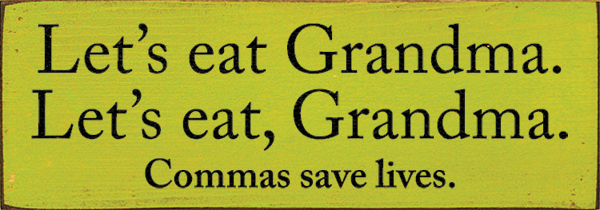Plenty of ink has been spilled and battles fought over the necessity and superiority of the Oxford or serial comma. After the period, the comma is the most used and misused punctuation mark. No doubt, we’ve all heard and seen that commas can kill.
A comma’s uses are myriad, and there are many rules about its usage. Whereas a period is an end punctuation mark, a comma indicates a pause or small break. We’ll start with one of the more common uses: joining clauses.
Independent clauses: Complete thoughts that stand on their own can be joined with a conjunction (and, but, or, so, yet, etc.) and a comma.
EX: The game went fifteen innings, but the Cubs lost on a fluke error.
EX: Mary couldn’t walk out of a fabric shop without at least purchasing a fat quarter, and Anne was only too happy to introduce her to every shop on the East Coast.
However, when verbs share a subject (compound predicate) they are not separated with a comma.
EX: Mary returned to the store for thread and hurried home to begin another project.
EX: The third baseman caught the fly ball and threw it to second for a double play.
A rare exception to this rule would permit a comma between the verbs if there was a possibility of misunderstanding as in the following example:
EX: Mary recognized the woman who took her parking space and giggled.
Without a comma, it’s not clear who giggled—Mary or the other woman. For clarity, insert a comma:
Mary recognized the woman who took her parking space, and giggled.
Independent clauses may also be joined with a conjunction and an adverb. In those cases, both a semi-colon and comma are used—the semi-colon before the conjunction, the comma following.
EX: The new shop carried Mary’s favorite line of fabric; however, it cost more than her meager budget allowed.
Follow the same punctuation pattern when using a transitional expression between two independent clauses, such as for example, in addition, namely.
EX: The Cubs earned a trip to the World Series for the first time since 1945; in addition, the young team has the potential for winning seasons for the next few years.
Commas are often used to set off introductory phrases. It’s not grammatically necessary to set off short introductory phrases of two or three words, but neither is it incorrect. Be aware of the publishers preferences and note these guidelines:
An introductory phrase that functions as an adverb indicating time, manner, place or degree, does not need a comma, unless the reader could be confused.
- At noon the whistle blows.
- On her desk are pictures of her grandchildren.
- At his leisure Bill read the morning paper.
- Too often the best answer is the common sense one.
Longer adverbial and other introductory phrases, however, are set off with commas.
Adverbial phrase:
EX: On the last Saturday of every month, the quilt guild holds a sewing day.
Adjective phrase modifies the subject of the independent clause:
EX: Of all the quilts at the show, Mary’s won the most ribbons.
Phrase contains a present or past participle:
EX: Coming off injured reserve, Schwarber hit a grand slam to put the Cubs ahead.
However, when a sentence begins with a gerund, a present participle that functions as a noun, it is the subject and is not separated from the verb with a comma.
EX: Designing one’s own quilt using computer software is becoming more common, even among novice quilters.
Next month we’ll look at more common uses of commas.







No Comments